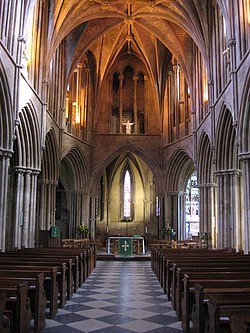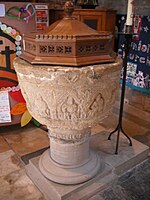
Saint Dunstan, OSB was an English bishop. He was successively Abbot of Glastonbury Abbey, Bishop of Worcester, Bishop of London and Archbishop of Canterbury, later canonised. His work restored monastic life in England and reformed the English Church. His 11th-century biographer Osbern, himself an artist and scribe, states that Dunstan was skilled in "making a picture and forming letters", as were other clergy of his age who reached senior rank. Dunstan served as an important minister of state to several English kings. He was the most popular saint in England for nearly two centuries, having gained fame for the many stories of his greatness, not least among which were those concerning his famed cunning in defeating the Devil.

Eadwig was King of England from 23 November 955 until his death. He was the elder son of Edmund I and his first wife Ælfgifu, who died in 944. Eadwig and his brother Edgar were young children when their father was killed trying to rescue his seneschal from attack by an outlawed thief on 26 May 946. As Edmund's sons were too young to rule he was succeeded by his brother Eadred, who suffered from ill health and died unmarried in his early 30s.

Edward, often called the Martyr, was King of the English from 975 until he was murdered in 978. Edward was the eldest son of King Edgar, but was not his father's acknowledged heir. On Edgar's death, the leadership of England was contested, with some supporting Edward's claim to be king and others supporting his younger half-brother Æthelred, recognised as a legitimate son of Edgar. Edward was chosen as king and was crowned by his main clerical supporters, the archbishops Dunstan of Canterbury and Oswald of York.

Edgar was King of England from 959 until his death. He became king of all England on his brother's death. He was the younger son of King Edmund I and his first wife Ælfgifu. A detailed account of Edgar's reign is not possible, because only a few events were recorded by chroniclers and monastic writers were more interested in recording the activities of the leaders of the church.
Æthelweard was an ealdorman and the author of a Latin version of the Anglo-Saxon Chronicle known as the Chronicon Æthelweardi. He was a kinsman of the royal family, being a descendant of the Anglo-Saxon King Æthelred I of Wessex, the elder brother of Alfred the Great.
Ælfthryth was Queen of the English from her marriage to King Edgar in 964 or 965 until Edgar's death in 975. She was a leading figure in the regency during the minority of her son King Æthelred the Unready between 978 and 984.
Ælfgifu was Queen of the English as wife of King Eadwig of England for a brief period of time until 957 or 958. What little is known of her comes primarily by way of Anglo-Saxon charters, possibly including a will, the Anglo-Saxon Chronicle and hostile anecdotes in works of hagiography. Her union with the king, annulled within a few years of Eadwig's reign, seems to have been a target for factional rivalries which surrounded the throne in the late 950s. By c. 1000, when the careers of the Benedictine reformers Dunstan and Oswald became the subject of hagiography, its memory had suffered heavy degradation. In the mid-960s, however, she appears to have become a well-to-do landowner on good terms with King Edgar and, through her will, a generous benefactress of ecclesiastical houses associated with the royal family, notably the Old Minster and New Minster at Winchester.

Æthelwold of Winchester was Bishop of Winchester from 963 to 984 and one of the leaders of the tenth-century monastic reform movement in Anglo-Saxon England.

Oswald of Worcester was Archbishop of York from 972 to his death in 992. He was of Danish ancestry, but brought up by his uncle, Oda, who sent him to France to the abbey of Fleury to become a monk. After a number of years at Fleury, Oswald returned to England at the request of his uncle, who died before Oswald returned. With his uncle's death, Oswald needed a patron and turned to another kinsman, Oskytel, who had recently become Archbishop of York. His activity for Oskytel attracted the notice of Archbishop Dunstan who had Oswald consecrated as Bishop of Worcester in 961. In 972, Oswald was promoted to the see of York, although he continued to hold Worcester also.
Ælfric Cild was a wealthy Anglo-Saxon nobleman from the east Midlands, Ealdorman of Mercia between 983 and 985, and possibly brother-in-law to his predecessor Ælfhere. He was also associated with the monastic reformer Æthelwold, bishop of Winchester, he is also notable for being involved in a number of land transactions for the refounding and endowment of Peterborough Abbey, as well as with Thorney Abbey during the 970s and early 980s.
Æthelstan Half-King was an important and influential Ealdorman of East Anglia who interacted with five kings of England, including his adopted son King Edgar the Peaceful. Many of Æthelstan's close relatives were also involved in important affairs, but soon after the death of King Eadred in 955, he left his position and became a monk at Glastonbury Abbey.
Sideman was Bishop of Crediton. He attested charters of King Edgar as abbot of Exeter from 969, and was appointed to the see of Crediton in 973. According to Byrhtferth of Ramsey, King Edward the Martyr "had been instructed in holy scripture under the tutelage of Bishop Sideman". The historian Cyril Hart describes him as a protégé of Ælfhere, ealdorman of Mercia. Sideman died on 30 April 977 at a meeting of a royal council at Kirtlington in Oxfordshire. He had expressed a wish to be buried at Crediton, but King Edward and Dunstan, Archbishop of Canterbury, ordered that he should be conveyed to Abingdon Abbey, where he was buried on the north side of St Paul's chapel.

Eadnoth the Younger or Eadnoth I was a medieval monk and prelate, successively Abbot of Ramsey and Bishop of Dorchester. From a prominent family of priests in the Fens, he was related to Oswald, Bishop of Worcester, Archbishop of York and founder of Ramsey Abbey. Following in the footsteps of his illustrious kinsman, he initially became a monk at Worcester. He is found at Ramsey supervising construction works in the 980s, and around 992 actually became Abbot of Ramsey. As abbot, he founded two daughter houses in what is now Cambridgeshire, namely, a monastery at St Ives and a nunnery at Chatteris. At some point between 1007 and 1009, he became Bishop of Dorchester, a see that encompassed much of the eastern Danelaw. He died at the Battle of Assandun in 1016, fighting Cnut the Great.
Ælfhere was Ealdorman of Mercia. His family, along with those of Æthelstan Half-King and Æthelstan Rota, rose to greatness in the middle third of the 10th century. In the reign of Edward the Martyr, Ælfhere was a leader of the anti-monastic reaction and an ally of Edward's stepmother Queen Dowager Ælfthryth. After the killing of Edward by Ælfthryth's servants in 978, Ælfhere supported the new king, Ælfthryth's son Æthelred the Unready, and was the leading nobleman in the Kingdom of England until his death in 983.
Æthelwine was ealdorman of East Anglia and one of the leading noblemen in the kingdom of England in the later 10th century. As with his kinsmen, the principal source for his life is Byrhtferth's life of Oswald of Worcester. Æthelwine founded Ramsey Abbey in 969, and Byrhtferth and Ramsey Abbey remembered him as Dei amicus, but the monks of nearby Ely saw him as an enemy who had seized their lands.

Odda of Deerhurst was an Anglo-Saxon nobleman active in the period from 1013 onwards. He became a leading magnate in 1051, following the exile of Godwin, Earl of Wessex and his sons and the confiscation of their property and earldoms, when King Edward the Confessor appointed Odda as earl over a portion of the vacated territory. Earl Godwin was later restored to royal favour, and his lands returned, while Odda received a new earldom in the west midlands in compensation. Odda became a monk late in life. He was buried at Pershore Abbey.
Events from the 10th century in the Kingdom of England.
Æthelmær the Stout or Æthelmær the Fat a leading thegn from the 980s, discðegn to King Æthelred the Unready, and briefly ealdorman of the Western Provinces in 1013. He was the founder of Cerne Abbey and Eynsham Abbey, and a patron of the leading scholar, Ælfric of Eynsham. He was the son of Æthelweard the historian, and descended from King Æthelred I.

The English Benedictine Reform or Monastic Reform of the English church in the late tenth century was a religious and intellectual movement in the later Anglo-Saxon period. In the mid-tenth century almost all monasteries were staffed by secular clergy, who were often married. The reformers sought to replace them with celibate contemplative monks following the Rule of Saint Benedict. The movement was inspired by Continental monastic reforms, and the leading figures were Dunstan, Archbishop of Canterbury, Æthelwold, Bishop of Winchester, and Oswald, Archbishop of York.

Ælfwynn or Ælfwyn was a member of a wealthy Anglo-Saxon family in Huntingdonshire who married Æthelstan Half-King, the powerful ealdorman of East Anglia, in about 932. She is chiefly known for having been foster-mother to the future King Edgar the Peaceful following his mother's death in 944, when he was an infant. She had four sons, and the youngest, Æthelwine, became the chief secular magnate and leading supporter of the monastic reform movement. Ælfwynn donated her estates for his foundation of Ramsey Abbey in 966 and was probably buried there.



















